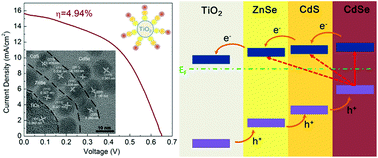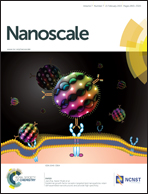Highly efficient quantum dot-sensitized TiO2 solar cells based on multilayered semiconductors (ZnSe/CdS/CdSe)†
Abstract
A new approach by inserting a layer of ZnSe QDs was studied to enhance the adsorption of CdS/CdSe QDs resulting in much improved power conversion efficiency. ZnSe, CdS and CdSe QDs were sequentially assembled on a nanocrystalline TiO2 film to prepare a ZnSe/CdS/CdSe sensitized photoelectrode for QD-sensitized solar cell (QDSSC) applications. The results show that the performance of QDSSCs is strongly dependent on the order of the QDs with respect to TiO2. The pre-assembled ZnSe QD layer acts as a seed layer in the subsequent SILAR process, inducing both the nucleation and growth of CdS QDs, whereas CdS and CdSe QDs have a complementary effect in light harvesting. In the cascade structure of TiO2/ZnSe/CdS/CdSe electrode, a high efficiency of 4.94% and a long electron lifetime of 87.4 ms were achieved, which can be attributed to the following factors: the higher intensity and red shift of light absorption in 400–700 nm range increase the electron concentration in TiO2 substrate sensitized by ZnSe/CdS/CdSe compared to the others, which directly accelerate electron transport in TiO2 and their transfer to FTO glass; the re-organization of energy levels among ZnSe, CdS and CdSe forms a stepwise structure of band-edge levels, which is advantageous to the electron injection and hole recovery of QDs.


 Please wait while we load your content...
Please wait while we load your content...